A semi-detached house in Singapore by HYLA Architects offers a rich experience through a series of cascading courtyards. Shortlisted in INDE.Awards 2018’s The Living Space category, could this project take home the awards?

June 12th, 2018
Courtyards are key features in the houses by HYLA Architects. Over the years, the practice has explored the courtyard as a means for the provision of privacy and the enjoyment of external spaces, as demonstrated beautifully in the house on Lily Avenue in Singapore.
For a new semi-detached house on a corner in Singapore’s west, similar considerations were factored into the design. “Privacy is always a concern for a corner site as the house can be fairly exposed,” explains Han Loke Kwang, HYLA’s Principal.
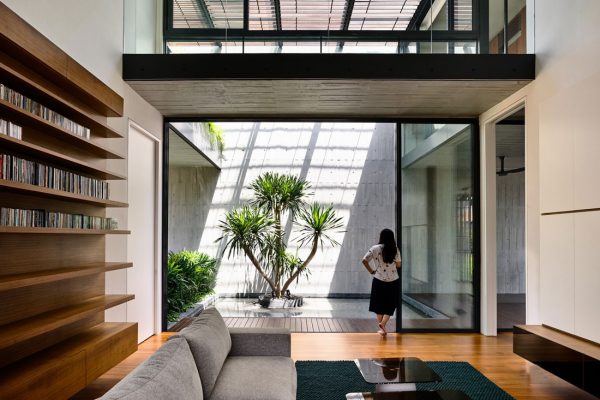
To address this, the design has a succession of internal courtyards placed between the parti wall and the main volume of the house, creating open-air spaces that are sheltered and that can be privately enjoyed. A pair of parallel staircases – one inside and one outside the main block – serve the common living areas and most of the bedrooms, leading up and down to the four outdoor courts.
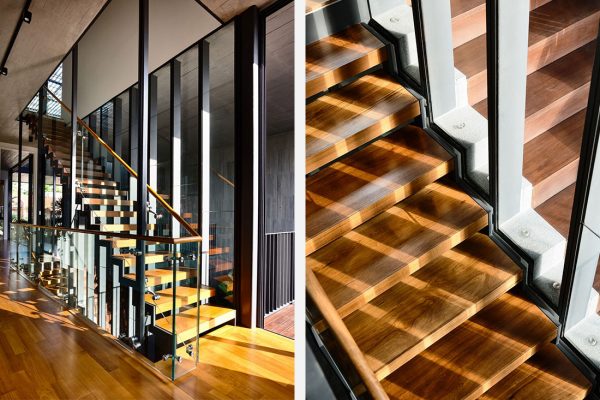
Han shares: “The cascade of outdoor spaces arises from a desire to create air flow through the house, and also to create views between the various levels. This brings a dynamic flow to the space, which is present in all my works. I make the [building] form stable but the spaces dynamic. By having all these different layered spaces, the eye is led from one space to the next. The building thus informs you what is happening and where to go next. The forms are stable as I believe it makes for a more classic and timeless expression.”
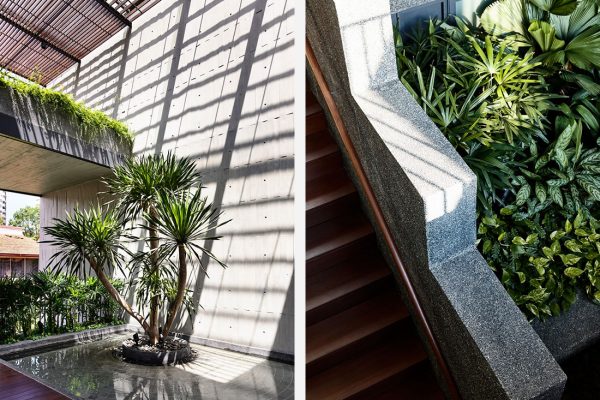
The iteration of terraces, garden decks and water court affords the architecture a unique landscaped experience within the house. Imaginably, for the residents, these courts (either viewed from the adjoined living spaces or experienced as one moves through the space) provide great enjoyment of both nature and architecture. Of the house experience, Han comments, “They don’t have to be just boxes inside boxes, and I try to make the outdoor spaces really significant and cut into the form – not small little cutouts.”

A timber screen protects house all along its side elevation, with an additional layer of luxuriant greenery (planted in the house’s ground-floor peripheral garden) adding to the sense of buffering.
Photography by Derek Swalwell (courtesy of HYLA Architects).
INDESIGN is on instagram
Follow @indesignlive
A searchable and comprehensive guide for specifying leading products and their suppliers
Keep up to date with the latest and greatest from our industry BFF's!

For Aidan Mawhinney, the secret ingredient to Living Edge’s success “comes down to people, product and place.” As the brand celebrates a significant 25-year milestone, it’s that commitment to authentic, sustainable design – and the people behind it all – that continues to anchor its legacy.
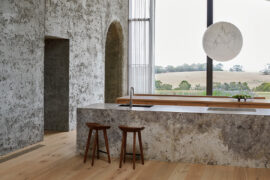
The INDE.Awards 2025 has named House on a Hill by Leeton Pointon Architects and Allison Pye Interiors as the winner of The Interior Space category, presented by Tongue & Groove. This multigenerational country home on Bunurong Country redefines residential architecture and design with its poetic balance of form, function, and sanctuary.

Leading by design, Erik L’Heureux has recently taken the helm of Monash University’s Department of Architecture, and so a new and exciting journey begins for both L’Heureux and the University.
The internet never sleeps! Here's the stuff you might have missed
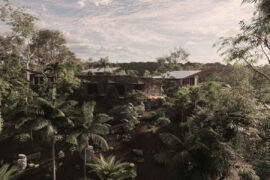
A collaboration of creatives led by Sam Crawford Architects has produced a concept for the ultimate on-Country experience that both respects and sensitively interacts with the landscape.

As a supporter of the 2025 INDE.Awards, COLORBOND® steel recognises the importance of the next generation of architects who are leading the way in creativity and innovation to help design and sustain our future.

The INDE.Awards 2025 has named House on a Hill by Leeton Pointon Architects and Allison Pye Interiors as the winner of The Interior Space category, presented by Tongue & Groove. This multigenerational country home on Bunurong Country redefines residential architecture and design with its poetic balance of form, function, and sanctuary.